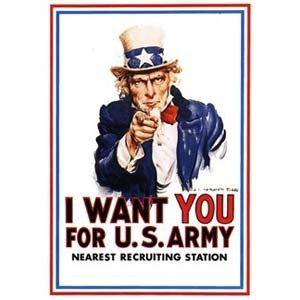J.M. Flagg created the Uncle Sam poster during the World War I period. The purpose of this poster was to increase interest in and to recruit soldiers for our nation’s armed forces. In this short analysis I will discuss the purpose, textual elements and visual elements of the Uncle Sam poster to show how they attract the attention of the reader, thus garnering enlistment and support for the U.S. Army.
 I believe that this poster was created to appeal to several different groups of people. First it targets strong brave young men that take pride in the country in which they live. These young men have the potential that Uncle Sam is looking to recruit into the military. Second, the poster targets those that have loved ones already serving in the armed forces. The poster in some way admonishes those people to support their loved ones and the military in which they serve. Lastly I believe it targets the general public and encourages their patriotism and support for those that keep our country safe.
I believe that this poster was created to appeal to several different groups of people. First it targets strong brave young men that take pride in the country in which they live. These young men have the potential that Uncle Sam is looking to recruit into the military. Second, the poster targets those that have loved ones already serving in the armed forces. The poster in some way admonishes those people to support their loved ones and the military in which they serve. Lastly I believe it targets the general public and encourages their patriotism and support for those that keep our country safe.
Uncle Sam is essentially the personification of the United States government. In times of war the government may not be viewed in such great light. So to call the man in the poster Uncle Sam makes this person a part of all of our families, which makes the issues he represents that much more personal and brings people together for a common cause.
There is no unnecessary music, words, graphics or audio message, so this poster steers clear of redundancy. Instead it utilizes the coherency principle very well. Flagg also utilizes the ethos and pathos elements of rhetorical appeals. We tend to respect Uncle Sam. So much so that refer to our entire military by his name. This respect for the character in the photo suggests the ethos element. Pathos is seen by the emotion and the patriotic vibe suggested by the colors in the poster. Most all Americans hold some loyalty to the American Flag, which is red, white and blue. Why would we not have some loyalty or emotional response to this poster which predominately uses those same colors?
My analysis of the poster finds that it is quite simple in nature, but these simple elements have big meaning. The first thing you notice is Uncle Sam pointing directly at you. Most people give full attention to someone pointing at them even when they don’t know this person. Uncle Sam’s stern look conveys the seriousness of the message that he’s sending. It’s almost as if he’s sending a command. He’s dressed in the colors of the U.S.A. flag. This brings home the idea that Uncle Sam represents a personification of the U.S. government. The background of the poster is stark white. There is nothing distracting the viewer from both Uncle Sam’s stern stare and the words it seems he’s saying directly to you, “I WANT YOU FOR U.S. ARMY.” The quote on the poster is written in the direct tone of voice. By using the pronoun “I” in the quote it seems as if Uncle Sam is speaking directly to the reader. These words are in all capital letters. This also adds to the sense that the message is very serious in nature and directly pointed at you, just like that forefinger. Notice that the word “YOU” is the only word in red. Since so many people will view this flyer, I think J.M. Flagg knew it was important to make it feel very personal. By having Uncle Sam pointing his finger and the word “YOU” in red, he succeeds in making the message feel directed to each viewer.
Flagg’s use of text, graphics and color successfully demand an attraction and emotional response to this poster!